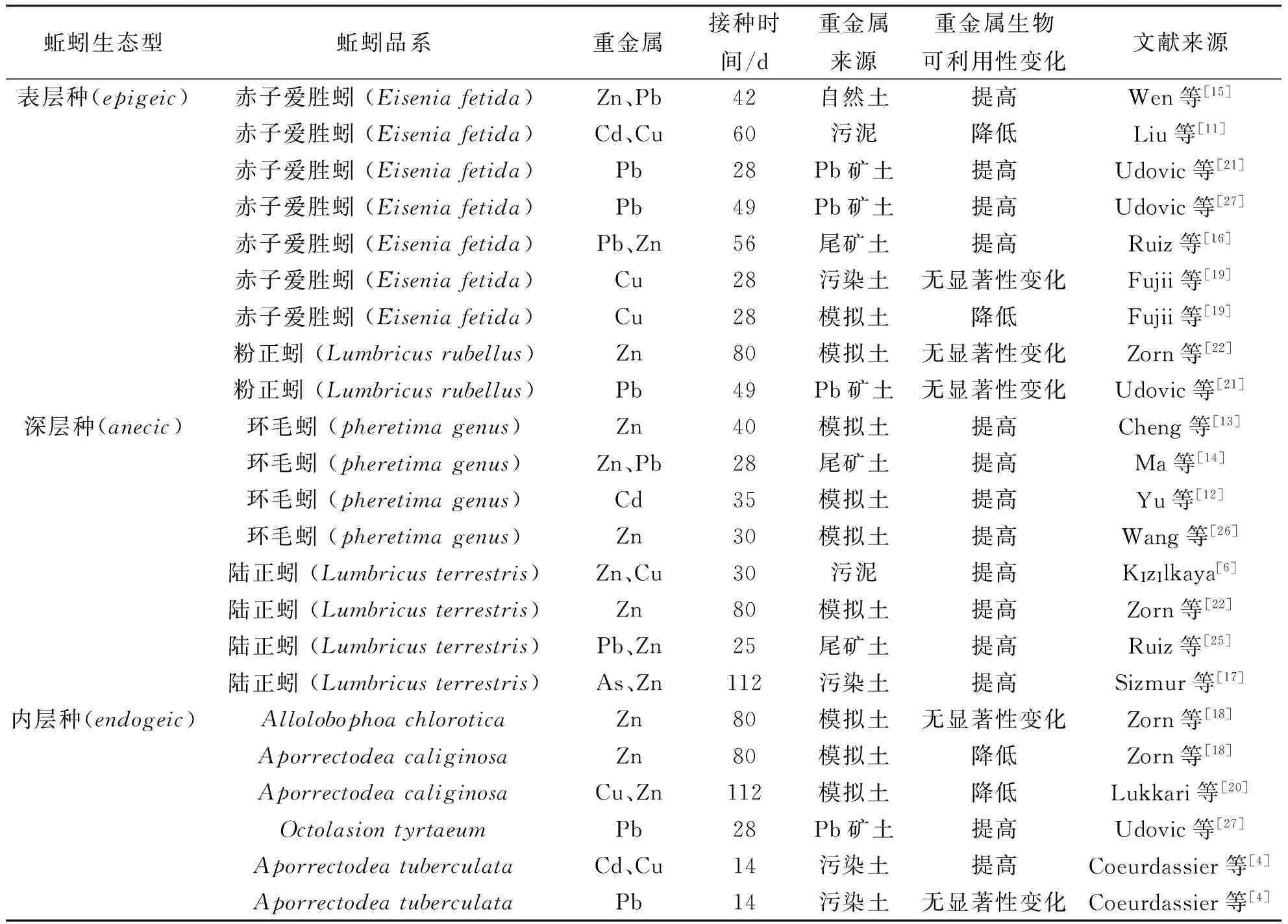蚯蚓处理对土壤中重金属生物可利用性的影响
胡 安,朱维琴,陈 林,贾秀英
(杭州师范大学生命与环境科学学院,浙江 杭州 310036)
蚯蚓处理对土壤中重金属生物可利用性的影响
胡 安,朱维琴,陈 林,贾秀英
(杭州师范大学生命与环境科学学院,浙江 杭州 310036)
随着对蚯蚓生态功能的深度挖掘,近年来开发出一种新型的污染物、废弃物处理处置技术:蚯蚓堆置处理技术.文章从蚯蚓生态型差异、土壤类型、重金属类型差异、pH值以及可溶性有机碳变化4个方面论述此技术对土壤中重金属生物可利用性的影响,以期为今后研究工作提供参考.
蚯蚓;生物可利用性;蚯蚓品系;土壤类型;重金属特异性
蚯蚓是土壤中的主要动物类群,它们可促进有机物质的分解与矿化,加速土壤中N、P、K等营养物质的循环,改善土壤结构,提升植物生物量,是维持土壤肥力的重要生物[1-2].此外,通过协同共生作用,蚯蚓也能影响土壤中的微生物和其它无脊椎动物[3-4].由于在有机质分解和营养物质循环过程中的重要作用,及其易辨别、易采样、分布广等特性,蚯蚓是极佳的土壤污染指示生物(重金属污染)[5].此外,众多研究发现蚯蚓对重金属具有一定的耐受性且其体内黄体组织中的黄色细胞能够富集重金属[6-9],因此,蚯蚓逐渐成为固废处理和重金属污染土壤生态修复的模式生物或辅助生物[10-11].
目前关于蚯蚓处理对土壤重金属生物可利用性(metals bioavailability)影响的研究报道甚多(见表1):大多数研究结果显示,蚯蚓处理能够提高重金属生物可利用性[12-17];但也有研究报道,蚯蚓处理降低了重金属生物可利用性[11, 18-20].文章拟从下述四方面探讨蚯蚓处理对重金属生物可利用性的影响:①蚯蚓生态型差异;②土壤类型;③重金属类型差异;④pH值、可溶性有机碳变化.
1 蚯蚓生态型差异
根据蚯蚓特化的适应能力和生态功能将蚯蚓划归为3类:表层种(epigeic)、深层种(anecic)、内层种(endogeic).表层种中应用最广泛的是赤子爱胜蚓(Eiseniafetida)[11, 15-16, 19],赤子爱胜蚓繁殖率高,成熟周期短(约8周),易于实验室批量培养,多个国际标准毒性试验也都将其列为参比蚓,这可能是其广受使用的原因之一.其次是粉正蚓(Lumbricusrubellus)[21-22]和赤子韦内塔(Eiseniaveneta)[23].在众多有关表层种处理对重金属生物可利用性影响的研究中,除Liu等[12]、Fujii等[19]、Udovic等[21]的研究结果外,其余研究结果大都揭示蚯蚓处理能够提高重金属生物可利用性(见表1).
深层种一般在土壤中挖掘垂直洞穴,洞穴内壁附着黏液、细菌及自身排泄物,它们多以有机残落物为食并将蚓粪排于地表,温带地区此类蚯蚓生物量占整个蚯蚓生物量的比重达80%以上[24].目前,围绕深层种蚯蚓展开的研究主要集中于陆正蚓(Lumbricusterrestris)和环毛蚓(pheretimagenus).欧洲地区对陆正蚓(Lumbricusterrestris)开展的研究较多[6, 17, 22, 25],这些研究结果一致显示陆正蚓(Lumbricusterrestris)处理可提高重金属生物可利用性(见表1);而有关环毛蚓(pheretimagenus)的研究主要集中在亚洲地区,这可能是由于地域限制所致,Yu等[12]、Ma等[14]、Wang等[26]都研究了环毛蚓(pheretimagenus)对植物吸收重金属的影响效应,结果表明环毛蚓(pheretimagenus)可显著提高植物对重金属的萃取能力;Cheng等[13]就环毛蚓(pheretimagenus)对土壤中Zn形态的影响进行了研究,其结果也表明环毛蚓(pheretimagenus)可提高Zn的生物可利用性.可见,不同于表层种,多数深层种均能提高重金属的生物可利用性.

表1 蚯蚓处理对土壤中重金属生物可利用性的影响Tab.1 Effects of earthworms activity on the bioavailability of heavy metals in soil
内层种一般栖于矿物土中,通常挖掘横向洞穴,以混合于土壤中的有机质为食.由于内层种样本采集不便、实验室不易培养,其在研究中应用得相对较少.Coeurdassier等[4]研究了Aporrectodeatuberculata对土壤中其他无脊椎动物的影响,发现其可促进蜗牛对Zn、Cd和Cu的吸收;Udovic等[27]研究揭示Octolasiontyrtaeum能提高Pb矿土中Pb的生物可利用性;而Lukkari等[20]研究揭示Aporrectodeacaliginosa可降低土壤中Cu和Zn的生物可利用性;Zorn等[18]对比研究2种不同的内层种Aporrectodeacaliginosa和Allolobophoachlorotica,发现Aporrectodeacaliginosa可显著降低Zn的生物可利用性,而Allolobophoachlorotica对Zn生物可利用性的影响并不显著.
综上可见,深层种大都能够提高重金属的生物可利用性,而表层种与内层种并未显现出一致趋势.此外,蚯蚓的生活史、遗传特性及其暴露时间亦会改变重金属的生物可利用性,例如,Lukkari等[20]研究发现前期有过重金属暴露史的Aporrectodeacaliginosa较之没有暴露史的Aporrectodeacaliginosa更能降低土壤中Cu和Zn的生物可利用性.因此,除了开展各生态种间的对比研究外,亦应重视蚯蚓暴露史这一重要因子.
2 土壤类型

针对外源添加重金属的人工土壤(简称模拟土壤)研究表明,蚯蚓处理对模拟土壤重金属生物可利用性的影响不一.例如,Zorn等[18]与Lukkari等[20]研究显示蚯蚓处理能够降低模拟土壤中重金属生物可利用性;Liu等[11]研究显示蚯蚓处理未显著改变模拟土壤中重金属生物可利用性;而Yu等[12]和Wang等[26]研究发现蚯蚓处理均可提高模拟土壤中重金属生物可利用性.此外,Fujii等[19]对比研究了受Cu污染田土与模拟土壤,发现蚯蚓处理能够降低模拟土壤中重金属生物可利用性,而受Cu污染田土中重金属的生物可利用性未发生显著变化.与自然土壤相比,利用模拟土壤可控制重金属暴露浓度,且能进行单一重金属的暴露,但其不能反映土壤的真实状况,且模拟土壤中重金属生物可利用性一般都会偏高[19].因此,若利用模拟土壤作为实验基质,则对于蚯蚓处理提高植物重金属萃取效率的相关研究结果需谨慎解读[12-13, 26].
总之,利用自然土壤作为实验基质时,蚯蚓处理一般都可提高土壤中重金属的生物可利用性,而模拟土壤中的研究结果各一(见表1).为此,除继续探究不同基质间的处理差异外,另一重点就是要研究蚓粪中重金属生物可利用性的变化,从而排除土壤老化[19]这一因素的干扰.
3 重金属类型差异
重金属元素可广义地划分为必需元素和非必需元素.所谓必需元素是指生物体新陈代谢过程中必不可少的元素,如Cu和Zn等;非必需元素则是指生物体生长发育代谢过程中不需要的元素,如重金属Cd和Pb等及准金属(metalloid) As[17].有报道指出,蚯蚓对于不同类型金属元素具有不同的适应性反应,且蚓体能够调控必需元素,实现吸收与排泄的动态平衡,最终达到内稳态[20];而非必需元素则可能通过与有机配体结合或隐遁于无机基质内实现脱毒[28].此外,不同重金属在土壤中具有不同的赋存形态,且与土壤结合强度也不一样,较之其它元素,Cu更多地与土壤中的有机质络合形成较稳定的腐殖质-金属络合物[6].Lukkari等[20]认为Cu与土壤的结合强度要高于Zn;而Zn则多以离子交换态和碳酸盐结合态形式存在;Pb主要以Fe-Mn氧化物等还原态形式存在[25];而土壤中有机和无机胶体对Cd的吸附能力较弱,故Cd移动性相对较强[4].因此,重金属类型差异及其不同的结合机制可能导致不同的影响效应,例如,Coeurdassier等[4]报道棕色污染土经Aporrectodeacaliginosa处理后,蜗牛体内Cu、Zn浓度显著提高,而Pb浓度未出现明显变化.Sizmur等[23]报道金属矿土经赤子韦内塔(Eiseniaveneta)处理后,水提取态Pb浓度明显增高,而水提取态Zn浓度呈下降趋势;Devliegher等[1]报道陆正蚓(Lumbricusterrestris)能够显著提高土壤中Cu有效态浓度, 但未改变Zn的有效态浓度.
4 pH值和可溶性有机碳变化
pH值是影响土壤溶液中重金属浓度的重要因子[29].有研究表明,蚯蚓可通过降低土壤pH值而增加重金属的生物可利用性[6, 12].然而,亦有研究指出由于蚯蚓皮肤黏液及钙腺分泌,蚯蚓处理可提高土壤pH值,但重金属生物可利用性仍然得到提高[14-15],这表明pH值变化并不足以揭示蚯蚓处理对重金属生物可利用性的影响效应.Steenbergen等[30]和Arnold等[31]研究表明,可溶性有机碳可通过络合反应或离子交换机制对重金属生物可利用性产生重大影响.Businelli等[32]在经蚯蚓处理后的土壤中检测到腐殖酸的存在,这一证据揭示蚯蚓处理具有腐殖化作用,而腐殖酸可明显提高植物体对重金属的利用率[33].亦有研究指出土壤经蚯蚓处理后可促进植物体对重金属的吸收,这可能是由于蚯蚓促成的金属-有机物螯合物释出的直接作用结果[26-27].Wen等[15]研究发现,赤子爱胜蚓能够提高土壤中可溶性有机碳(dissolved organic carbon)的含量,且DOC含量与水提取态重金属浓度(Zn、Cu、Cr、Cd和Pb)呈显著相关性.另有研究[34]报道DOC含量与水提取态稀土元素(Y、La、Ce、Pr和Nd)也呈正相关.此外,Wang等[26]研究亦发现环毛蚓(pheretimagenus)处理提高了土壤中Cu的生物可利用性,同时检测到DOC含量呈相应增加趋势.综上,pH值和土壤中DOC含量的变化对土壤重金属的生物可利用性具有重要意义.
5 建议和展望
有关蚯蚓处理影响重金属生物可利用性的研究将会是持续热点.影响重金属生物可利用性的因素众多,今后应特别注意以下几点:①实验基质宜挑选真实的重金属污染土或污泥等废弃物,不宜使用模拟土壤,因为重金属在基质中存留的时间不一,其形态特性也可能不一.②不同品种、不同生态型蚯蚓吸收富集重金属的能力及稳态时间不一致,实验应探明每种蚯蚓的最佳处理周期,在此基础上继续探究重金属生物可利用性的变化.③测定重金属生物可利用性时应更多地借助生物方法,如利用植物或土壤中无脊椎动物等来判定重金属生物可利用性的变化.④关注蚓粪中重金属生物可利用性的变化,以明确蚯蚓本身对重金属生物可利用性的直接影响.
[1] Devliegher W, Verstraete W. The effect ofLumbricusterrestrison soil in relation to plant growth: Effects of nutrient-enrichment processes (NEP) and gut-associated processes (GAP)[J]. Soil Biol Biochem,1997,29(3/4):341-346.
[2] Kocik A, Truchan M, Rozen A. Application of willows (Salixviminalis) and earthworms (Eiseniafetida) in sewage sludge treatment[J]. Eur J Soil Biol,2007,43(S1):327-331.
[3] Lavelle P. Diversity of soil fauna and ecosystem function[J]. Biol Int,1996,33:3-16.
[4] Coeurdassier M, Scheifler R, Vaufleury A,etal. Earthworms influence metal transfer from soil to snails[J]. Appl Soil Ecol,2007,35(2):302-310.
[5] Li Mei, Liu Zhengtao, Xu Yun,etal. Comparative effects of Cd and Pb on biochemical response and DNA damage in the earthwormEiseniafetida(Annelida,Oligochaeta)[J]. Chemosphere,2009,74(5):621-625.
[6] Klzllkaya R. Cu and Zn accumulation in earthwormLumbricusterrestrisL. in sewage sludge amended soil and fractions of Cu and Zn in casts and surrounding soil[J]. Ecol Eng,2004,22(2):141-151.
[7] Li Lingxiangyu, Xu Zhenlan, Wu Jianyang,etal. Bioaccumulation of heavy metals in the earthwormEiseniafetidain relation to bioavailable metal concentrations in pig manure[J]. Bioresource Technol,2010,101(10):3430-3436.
[8] Dai J, Becquer T, Rouiller J H,etal. Heavy metal accumulation by two earthworm species and its relationship to total and DTPA-extractable metals in soils[J]. Soil Boil Biochem,2004,36(1):91-98.
[9] Fischer E, Molnar L. Environmental aspects of the chloragogenous tissue of earthworms[J]. Soil Biol Biochem,1992,24(12):1723-1727.
[10] Suthar S. Pilot-scale vermireactors for sewage sludge stabilization and metal remediation process: Comparison with small-scale vermireactors[J]. Ecol Eng,2010,36(5):703-712.
[11] Liu Xiaoli, Hu Chengxiao, Zhang Shuzhen. Effects of earthworm activity on fertility and heavy metal bioavailability in sewage sludge[J]. Environ Int,2005,31(6):874-879.
[12] Yu Xiezhi, Cheng Jieming, Wong M H. Earthworm-mycorrhiza interaction on Cd uptake and growth of ryegrass[J]. Soil Boil Biochem,2005,37(2):195-201.
[13] Cheng Jieming, Wong M H. Effects of earthworms on Zn fractionation in soils[J]. Biol Fertil Soils,2002,36(1):72-78.
[14] Ma Y, Dickinson N M, Wong M H. Toxicity of Pb/Zn mine tailings to the earthwormPheretimaand the effects of burrowing on metal availability[J]. Biol Fertil Soils,2002,36(1):79-86.
[15] Wen Bei, Hu Xiaoyu, Liu Ying,etal. The role of earthworms (Eiseniafetida) in influencing bioavailability of heavy metals in soils[J]. Biol Fertil Soils,2004,40(3):181-187.
[16] Ruiz E, Rodríguez L, Alonso-Azcárate J. Effects of earthworms on metal uptake of heavy metals from polluted mine soils by different crop plants[J]. Chemosphere,2009,75(8):1035-1041.
[17] Sizmur T, Roe P B, Watts M J,etal. Impact of the earthwormLumbricusterrestris(L.) on As, Cu, Pb and Zn mobility and speciation in contaminated soils[J]. Environ Pollut,2011,159(3):742-748.
[18] Zorn M I, Gestel C V, Eijsackers H. The effect of two endogeic earthworm species on zinc distribution and availability in artificial soil columns[J]. Soil Biol Biochem,2005,37:917-925.
[19] Fujii Y, Kaneko N. The effect of earthworms on copper fractionation of freshly and long-term polluted soils[J]. Ecotox Environ Safe,2009,72(6):1754-1759.
[20] Lukkari T, Teno S, Vaisanen A,etal. Effects of earthworms on decomposition and metal availability in contaminated soil: Microcosm studies of populations with different exposure histories[J]. Soil Biol Biochem,2006,38(2):359-370.
[21] Udovic M, Lestan D. The effect of earthworms on the fractionation and bioavailability of heavy metals before and after soil remediation[J]. Environ Pollut,2007,148(2):663-668.
[22] Zorn M I, Van Gestel C V, Eijsackers H. The effect ofLumbricusrubellusandLumbricusterrestrison zinc distribution and availability in artificial soil columns[J]. Biol Fertili Soils,2005,41(3):212-215.
[23] Sizmur T, Hodson M E. The impact ofEiseniavenetaon As, Cu, Pb and Zn uptake by ryegrass (LoliumperenneL.)[J]. Mineral Mag,2008,72(1):495-499.
[24] Binet F, Curmi P. Structural effects ofLumbricusterrestris(oligochaeta:lumbricidae) on the soil-organic matter system: Micromorphological observations and autoradiographs[J]. Soil Biol Biochem,1992,24(12):1519-1523.
[25] Ruiz E, Alonso-Azcárate J, Rodríguez L.LumbricusterrestrisL. activity increases the availability of metals and their accumulation in maize and barley[J]. Environ Pollut,2011,159(3):722-728.
[26] Wang Dandan, Li Huixin, Wei Zhenggui,etal. Effect of earthworms on the phytoremediation of zinc-polluted soil by ryegrass and Indian mustard[J]. Biol Fertil Soils,2006,43(1):120-123.
[27] Udovic M, Plavc Z, Lestan D. The effect of earthworms on the fractionation, mobility and bioavailability of Pb, Zn and Cd before and after soil leaching with EDTA[J]. Chemosphere,2007,70(1):126-134.
[28] Spurgeon D J, Hopkin S P. Comparisons of metal accumulation and excretion kinetics in earthworms (Eiseniafetida) exposed to contaminated field and laboratory soils[J]. Appl Soil Ecol,1999,11(2/3):227-243.
[29] Sauve S, Hendershot W, Allen H E. Solid-solution partitioning of metals in contaminated soils: dependence on pH, total metal burden, and organic matter[J]. Environ Sci Technol,2000,34(7):1125-1131.
[30] Steenbergen N T, Iaccino F, Winkel M D,etal. Development of a biotic ligand model and a regression model predicting acute Cu toxicity to the earthwormAporrectodeacaliginosa[J]. Environ Sci Technol,2005,39(15):5694-5702.
[31] Arnold R E, Hodson M E, Comber S,etal. Effect of organic complexation on the toxicity of Cu to the earthwormEiseniafetida[J]. Appl Geochem,2007,22(11):2397-2405.
[32] Businelli M, Perucci P, Patumi M,etal. Chemical composition and enzymic activity of some worm casts[J]. Plant and Soil,1984,80:417-422.
[33] Evangelou M, Daghan H, Schaeffer A. The influence of humic acids on the phytoextraction of cadmium from soil[J]. Chemosphere,2004,57(3):207-213.
[34] Wen Bei, Liu Ying, Hu Xiaoyu,etal. Effect of earthworms (Eiseniafetida) on the fractionation and bioavailability of rare earth elements in nine Chinese soils[J]. Chemosphere,2006,63(7):1179-1186.
EffectsofEarthwormDisposalontheBioavailabilityofHeavyMetalsinSoil
HU An, ZHU Wei-qin, CHEN Lin, JIA Xiu-ying
(College of Life and Environmental Sciences, Hangzhou Normal University, Hangzhou 310036, China)
Vermicomposting, which was a disposal technology for waste and contaminants, was recently developed along with the deep exploitation of earthworm ecological functions. The paper exposed the effects of the technology on the bioavailability of heavy metals in soil from four different perspectives of earthworm ecological differences, soil categories, heavy metal category differences as well as the change of pH and dissolved organic carbon (DOC), the results can provide references for future work.
earthworm; bioavailability; earthworm species; soil categories; heavy metal specificity
2012-01-03
杭州市重点实验室项目(20090233T14);浙江省自然科学基金项目(Y306160).
贾秀英(1966—),女,教授,主要从事环境毒理学研究.E-mail:xy_jia@163.com
11.3969/j.issn.1674-232X.2012.04.016
X53
A
1674-232X(2012)04-0369-05

